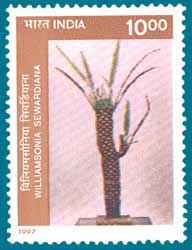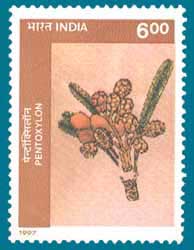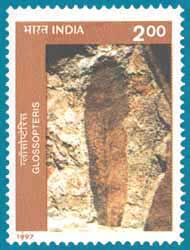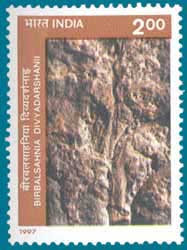|
Fossils on Stamps
BIRBAL SAHNI INSTITUTE OF PALAEOBOTANY, LUCKNOW
Palaeobotany is the study of plant fossils preserved in rocks. The word "Fossil" has been defined as "any evidence of prehistoric life". Plant fossils were formed by burial and preservation in the sediments in the geological past. During transport to the site of burial the plant parts underwent decomposition and deformation in varying degrees. The environment of depositional site control the preservation of these plant remains. Research in the science of palaeobotany deals with both large and minute plant fossils as they help to deduce the antiquity, radiation and evolutionary pattern of life on earth, the vegetation which was responsible for coal/oil reserves on earth, environment and climate of the past and correlation of sedimentary sequences. The first mention of a fossil plant was made by a German scholar Aibertus Magnus in the thirteenth century. In India, the first fossil plant was recorded in the later part of the eighteenth century, although detailed studies were carried out only in the later half of the nineteenth century, almost entirely at the Geological Survey of India, Calcutta. Professor Birbal Sahni was the first Indian to revitalize study of Indian fossil plants. He was a visionary in that he saw the potential of palaeobotanical research in India in understanding plant evolution through the ages and application of this knowledge for human welfare. It was through Prof. Sahni's efforts and zeal that the Institute of Palaeobotany was founded in September 1946 at Lucknow. The Institute functions as an autonomous research organization under the Department of Science and Technology, Government of India, to develop scientific knowledge and expertise in all branches of palaeobotany and related disciplines. The set of four stamps issued by the Department of Posts to commemorate the fiftieth anniversary of the Birbal Sahni Institute of Paleobotany in Lucknow, Uttar Pradesh, depict the richness and variety of plant fossils. _____________________________________________________
Williamsonia sewardiana - A model of the extinct plant Williamsonia sewardiana which thrived in Rajmahal, Bihar about 140 million years ago. This model is based on the reconstruction envisaged by Prof. Birbal Sahni. _____________________________________________________
Pentoxylon - An important discovery of Prof. Birbal Sahni is the extinct plant group named Pentoxylae from Nipania in Dumka district, Rajmahal Hills, Bihar (age 110-114 million years). Reconstruction of plant with leaves, stem, flowers. _____________________________________________________
Glossopteris - The tongue-shaped leaf Glossopteris, represents a unique group of extinct vascular plants (age : Permian, 250-280 million years). During this period India occupied a position south of equator close to South Pole as a part of a very large continent which included South America, Antarctica, Africa and Australia, called Gondwanaland. This vegetation was responsible for the precious coal reserves in peninsular India. _____________________________________________________
Birbalsahnia divyadarshanii - Fossil of an enigmatic flower-like organ of the extinct plant named after eminent Indian Palaeobotanists — Prof. Birbal Sahni and Prof. Divya Darshan Pant, discovered from Hura Coalfield, Santhal Pargana, Bihar (age 250-280 million years).
Date of Issue: 11.9.1997
|
||||||||||||||||||||||||||||||||||||||||||||||||||||||



